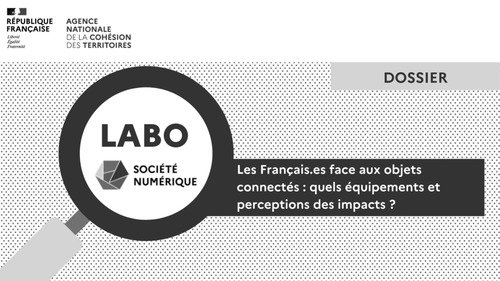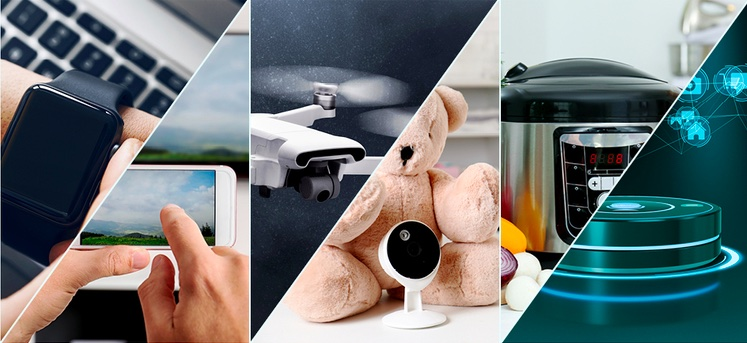
The first generation of connected objects was born in the early 2010s with the first connected bracelets.
The idea that the most everyday objects (resulting from previous industrial revolutions), household appliances, watches, glasses, toys, medical devices, sports accessories, clothes, would, with the addition of sensors and communication capabilities, move one by one into the digital age was then obvious.
In the meantime, many studies have highlighted the environmental impact of connected objects. As well as the infringements and risks in terms of privacy.
In 2021, 37% of French people have at least one connected object in their home.
37% of French people have at least one connected object in their home
The 2021 edition of the Digital Barometer observes a significant increase in connected object equipment. "While 5G is not yet available, the year 2020 marks a doubling of all equipment surveyed."
Références :
23% of respondents say they own a connected object related to health (compared to 11% last year), 17% a connected object related to household appliances (6% last year), 15% a connected object related to security (6% in 2019) and 14% a connected object related to home automation (5% last year).
In total, more than one person in three (37%, compared to 16% last year) is equipped in his home with at least one connected object. "The period of confinement, and therefore the forced withdrawal into the domestic sphere, comment the analysts of Credoc, " has undoubtedly contributed to a strengthening of the craze for home equipment.
- The increase concerns men (+22 points) and women (+19 points), low-income earners (+27 points) and high-income earners (+19 points), the least educated (+25 points) and those with higher education (+24 points), and those living in rural areas as well as those living in Paris and its suburbs (+21 points in both cases)
- Only the 12-17 year olds stand out, with a rate that is virtually unchanged from last year: one third of them were already equipped, whereas a majority of adults under 40 are equipped this year (60% of 18-24 year olds and 50% of 25-49 year olds, Figure 19).
- The influence of the standard of living or level of education on the equipment of connected objects has diminished slightly, but the most educated (45%) remain, along with the holders of the highest incomes (44%), the inhabitants of Paris and its suburbs (44%) or the executives (54%) among the groups most equipped with connected objects.
- 28% of respondents say, for the four sets of connected objects surveyed, that they are not likely to use them in the future (54% last year).
A rather mixed public perception of the positive and negative effects of connected objects
The " The French and new technologies" by Ademe explores public attitudes towards a series of innovative technologies. Along with smartphone applications, 5G and smart meters, connected objects are among the seven digital technologies that Ademe asks respondents to consider in order to understand how the public assesses the consequences of the development of a particular technology.
Respondents are first asked to indicate whether they consider the consequences of each of the tested technologies " positive or negative". This is done in five main areas: user health, user safety, the environment, user quality of life and the French economy. The survey uses a rating scale from zero to ten: 0 meaning very negative consequences, 10 very positive consequences, 5 no real consequences.
Référence :
Among all the technological developments tested in this survey, connected objects get an average score of 5.4 out of ten, which places connected objects in the middle of the table, ahead of communicating meters (5.3) and 5G (5.1), the lowest rated innovations.
In the second phase of this survey, respondents are given information about connected objects in the form of arguments for and against. The main advantage that connected objects offer, in the eyes of all respondents, is the improvement of comfort and services to users and the simplification of daily life (respectively 27% and 37%).
- 54% of the respondents declare that these explanations allowed them to better understand what connected objects were, 29% indicate that they already knew this information. In the end, 83% declare that they understand connected objects rather well.
- 38% say they are ready to use them and 12% are already using them.
- 26% of respondents believe that connected objects have more advantages than disadvantages, 43% as many disadvantages as advantages.
- 30% believe, however, that they have more disadvantages than advantages: a relatively high score, says Ademe: "only electric vehicles and 5G do less well on this issue.
Among the main disadvantages of connected objects, the respondents place the increase in energy consumption and GHG emissions (27%), cybersecurity issues (23%) and access to users' personal data (18%) at the top.
This is followed by the increase in resource consumption, excluding energy consumption (11%) and the inequality between those who have access and those who do not (10%).
Privacy risks of connected objects
The CNIL proposed to five doctoral students to conduct a series of analyses on various ordinary connected objects, purchased from online stores: The objective was to analyze both the security of the objects (identification of weak points through which an unauthorized user could potentially break in) and the processing of the user's personal data. The study also aimed at questioning the benefit/risk ratio in relation to the aspects of certain objects: "is it really, for example, an asset to have a camera in an alarm clock compared to the risks that this camera can bring?
- low-cost video surveillance cameras,
- connected toys,
- medical devices,
- connected speakers.
The analysis revealed significant security vulnerabilities:
"The connected objects studied do not necessarily share the same security flaws or the same privacy policy, but they all present significant risks. On the least expensive objects, we observed an absence of security measures, on the more high-end objects it is mainly at the level of information of people that questions arose."" In all cases," the authors of the study conclude, " the consequences of these risks for the privacy of users are significant. Indeed, this can range from the recovery and storage of personal data to the activation and use by a third party outside the home of an object filming our home".
Référence :
Why do we connect objects? From connected objects to communicating objects
"Connected, communicating and augmented objects have been the stuff of dreams for many years. For a long time, we have been announcing the "revolution" that all these objects would bring in their wake. If their number is constantly increasing and their uses are developing, if communicating objects are constantly invading our daily lives, can we really talk about a revolution?
The Annales des Mines-Enjeux numériques magazine, in an issue coordinated by Anne-Lise Thouroude, proposes " to show the point of view and the vision of the various stakeholders in the creation of value(s) of connected objects, and thus to open some doors to enlighten the reader on the evolutions of communicating objects".
"Could the intrinsic value of communicating objects lie not in the objects themselves but in the fact that they communicate, thus creating a value chain?" asks Anne-Lise Thouroude in her introduction. "Indeed, for value to be created, we must not only connect the objects but also collect, transport, analyze and then value and share the data. It is from this complete set that concrete applications and economic or societal benefits are born, in other words, value creation. The value of communicating objects is therefore based on three main aspects: the objects themselves, connectivity, and finally the data and its processing.
- The introduction of this issue is followed by a return to the imaginary of the Internet of Things and the history of connected objects.
- The first part of the issue illustrates the diversity of uses of communicating objects.
- The second part provides a picture of the technologies.
- The third part (the internet of personal objects: an oxymoron?) opens a reflection on the societal issues raised by connected objects.
Référence :





